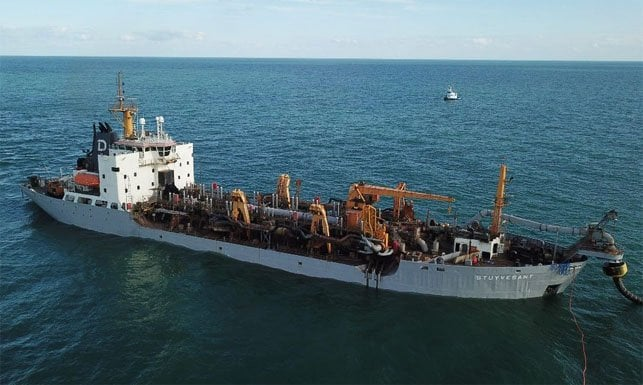Recently, the U.S. National Transportation Safety Board (NTSB) released its investigation report on the engine room fire incident aboard the American-flagged dredger Stuyvesant in November 2024.

The report indicated that inadequate inspections following routine maintenance failed to detect a missing filler cap, leading to lubricant leakage and ultimately triggering the fire. The accident resulted in the tragic death of the chief engineer and caused $18 million in vessel damage.
At the time of the incident, the dredger Stuyvesant was conducting dredging operations. At noon on November 2, 2024, during a break in the Stuyvesant’s operations, the chief engineer instructed crew members to perform routine maintenance on the port auxiliary engine. Although the vessel was built in 1982, the auxiliary engine had been replaced in December 2022 due to reaching the end of its service life.
The auxiliary engine was shut down due to reduced power required by the vessel during the dredging operation suspension. The maintenance task, which included draining and replacing the engine oil and filters, was a routine procedure and the crew considered it successfully completed.
Subsequently, the first engineer and an oiler returned to the main control room (MCR) and reported to the bridge that a remote restart operation had been performed after completing the maintenance task. Less than a minute after engine start-up, the first engineer and oiler observed flames in the engine room. Moments later, deck crew members also noticed smoke coming from the engine room and reported it to the bridge.
The engineer later stated to the NTSB: The first engineer opened the port side MCR door, causing flames from the engine room to spread into that area. The first engineer immediately grabbed a fire extinguisher, but the engineer reported that within less than a minute, the engine room was engulfed in thick smoke, visibility plummeted, and breathing became difficult. After escaping through the emergency passageway, he discovered the first engineer was still trapped inside.
Although the ship’s emergency response team ultimately rescued the first engineer from the engine control room, he had lost consciousness by the time he was transferred to the deck. Crew members continued performing CPR until the local fire and rescue team arrived and transported the first engineer to the hospital. He was later transferred to a second hospital, where he was pronounced dead.
The report states that the fire destroyed approximately 300 electrical and signal cables in the ship’s engine room, requiring replacement, with estimated losses amounting to $18 million.
During the post-fire inspection of the engine room, investigators discovered that the fuel and lube oil filters removed from the port auxiliary engine during routine maintenance were found intact inside a barrel next to the port auxiliary engine, having not been destroyed by the fire. The lube oil filter cap for the port auxiliary engine had not been reinstalled, and the lube oil filter housing plug had not been screwed into the internal threaded connection. This component, along with a wrench, was found placed on a nearby storage cabinet.
The NTSB determined that crew members failed to conduct a standard inspection after completing their tasks, thereby missing the absence of the filler cap. After engine startup, lubricating oil splashed onto the high-temperature manifold, igniting a fire. Since the crew was not present at the scene but instead remotely started the engine, they were unable to promptly detect the fire.
The NTSB warned that strict adherence to the manufacturer’s operating instructions is essential, and revealed that the dredger operator has made several modifications to the relevant procedures. One key change requires that the engine be started by a crew member at the engine location, rather than remotely. This allows the crew to immediately verify that the engine is operating according to the manufacturer’s specifications: no fuel/lubricant/water leaks, and no abnormal noise or vibration that would necessitate an emergency shutdown.
The NTSB warns that strict adherence to the manufacturer’s operating instructions is essential and reveals that the dredger operator has made multiple amendments to relevant procedures. One critical change requires crew members to start the engine from its vicinity rather than via remote operation. This allows crew to immediately verify whether engine operation meets manufacturer specifications: no fuel/lubricant/water leaks, and no abnormal noises or vibrations necessitating emergency shutdown.


